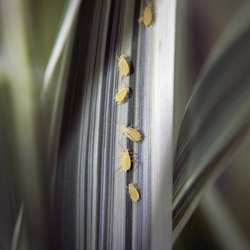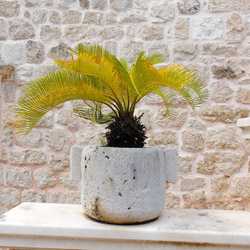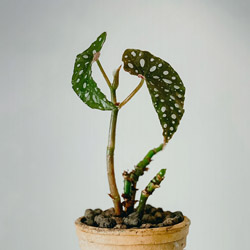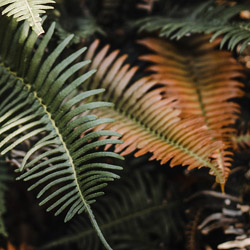Houseplants bring a refreshing touch of nature indoors, infusing our living spaces with cleaner air and other benefits. It can be distressing if houseplants fail to thrive, and we will also lose their benefits if the plants aren’t healthy. Recognizing the common signs of an unhealthy houseplant is easy, however, and it is simple to adjust care to help the plants become lush and beautiful again.
Challenges Indoor Plants Face
Whether plants live in the garden or are potted in the house, they still need rich soil, adequate sunlight, proper watering, and sufficient space to reach their full potential. Indoor spaces, however, often have lower sunlight levels, exceptionally dry air, and may have higher concentrations of airborne chemicals, including perfumes, cooking residue, and cleaning products. Potted houseplants may become cramped and use up the nutrition in their limited soil, and they may be disturbed by enthusiastic children or curious pets.
A houseplant may express the challenges it faces in different ways. By recognizing those signs of an unhealthy and unhappy houseplant, we can more quickly correct the issues and help the plant recover and thrive.
Top 10 Signs of Unhealthy Houseplants – And How to Fix Them
Different houseplants have different tolerances for less-than-ideal conditions, but when they start to show signs of poor health, it is easy to fix those problems and help plants return to their best growth and productivity.
- Spindly, Leggy, Lanky Growth
If a houseplant isn’t getting enough sunlight, it may start to stretch and tilt as it reaches toward what light is available. This creates longer stems and stalks instead of compact growth, causing the plant to look ragged. To correct this, simply move the plant to a better position in a west- or south-facing window to receive more sunlight. Opening nearby curtains or blinds can improve the sunlight level or add a grow light to provide supplemental light. - Scorched Leaves
Some plants can actually get too much light, which creates burn-like scorch marks on the foliage. This is easily corrected by moving the plant into indirect light rather than in direct sunlight. If the plant cannot be moved, window coverings can be adjusted to filter light. While scorched leaves will not heal, carefully trimming them with sharp pruners will easily restore the plant’s healthy appearance. - Wilting, Drooping, or Sagging Foliage
Plants wilt when their watering is improper, but it is often assumed that wilted plants are always thirsty. While this can be true, plants may also wilt if they are overwatered and their roots have begun to rot, which prevents the plant from absorbing enough nutrition and moisture to keep its foliage upright. Check the plant’s soil for moisture – a moisture reader is easy and accurate – and adjust to a regular watering schedule to keep the soil evenly moist without too much or too little water. - Lack of Flowers
Many houseplants produce beautiful flowers, but if the plant isn’t flowering at all, there may be a problem. Plants receiving too much nitrogen will push that nutrition into growing more foliage rather than blooming. Choosing a balanced fertilizer or one specially formulated to enhance flowering is an easy fix, and reducing feeding will keep the plant from getting overwhelmed with too much food and overly abundant foliage. - Fading Foliage Color
Some plants have showy leaves that are outstanding in indoor spaces, but if the plant’s color begins to fade or variegated leaves grow dull and single-colored, the plant may not be getting enough bright light to support color production. Moving the plant to a brighter room, opening window coverings, or using a supplemental grow light will help the plant brighten up again. Gently cleaning the foliage with a soft cloth will also keep it from being dulled by dust. - Yellowing Foliage
Yellow is one foliage color that often indicates poor health. Several causes can lead to yellowing leaves, including overwatering, soggy soil, or low humidity. Adjusting a plant’s watering schedule can help correct this problem or moving the plant to a bigger pot with good drainage holes where the soil will drain more easily can keep sogginess at bay. A small humidifier can improve a room’s ambient humidity, or use a pebble tray underneath plants to improve humidity right around the foliage. - Brown Leaf Tips
If just the leaf tips are turning brown and crispy, the plant may not be getting enough water to reach all the way to the tips of its foliage. Too much fertilizer or an accumulation of salts in the pot’s soil can also lead to brown tips. Slowing a feeding schedule can help, and when watering the plant, it should be thoroughly watered so extra water drains out the bottom of the pot to flush away salt buildup or excess fertilizer. Using a saucer beneath the pot can protect surfaces yet still ensure proper drainage and watering. - Deformed Leaves With a White Powder
If leaves look dusted with powder and are growing in odd, twisted ways, the plant is suffering from powdery mildew. This is caused by wet foliage, too much humidity, and poor air circulation, but it’s easily corrected. Avoid misting the plant or getting water on its foliage, and instead use a thin-spouted watering can to reach below foliage. Prune away some leaves to improve air circulation, and consider turning on a fan, opening a window, or otherwise improving air circulation to keep the plant healthy. - White Crust on the Soil
A gray or whitish crust on top of a plant’s soil indicates salt buildup. The crust can be scraped off, but the plant’s watering needs to be adjusted to prevent a recurrence that could eventually damage the plant’s roots. Thorough watering that runs out the pot’s drainage holes will minimize salt accumulation. Switching water sources – using distilled water or collecting rainwater for houseplants – can also fix this problem. Rain barrels are easy to install and can ensure plenty of water for every houseplant, with more for the garden. - Pests
Fungus gnats, mites, scale, mealybugs, and even aphids can infest an unhealthy houseplant. If any tiny pests are flittering about the plant, attached to leaves, or crawling on the soil, try to catch a sample and take it to the garden center for help in proper identification. Some pests can be wiped or picked off houseplants, while others may need treatment from insecticidal soaps to deter them. Improving watering, soil quality, air circulation, and overall plant health will also help keep pests away.
While it may seem as though there are many ways houseplants can quickly deteriorate, recognizing the signs of distress can make it much easier to reverse difficulties and restore plants to good health.





